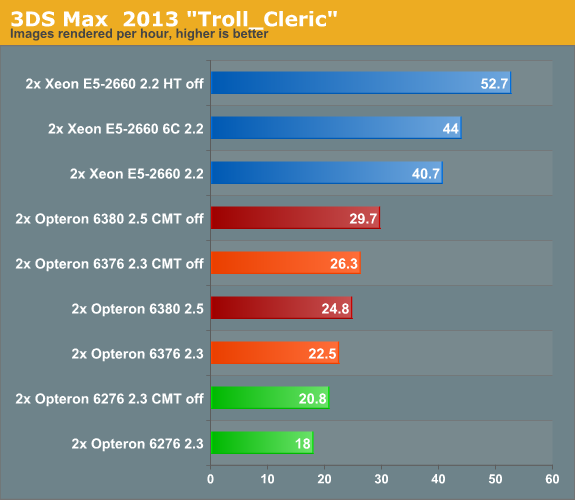The new Opteron 6300: Finally Tested!
by Johan De Gelas on February 20, 2013 12:03 AM EST3DS MAX 2013
Our previous benchmark, the "architecture" scene that is included in the SPEC APC 3DS Max 2007 test, was getting way too old. So we decided to switch to the "Trol_cleric29_max2010" scene while upgrading to 3DS MAX 2013. We render at 1080p (1920x1080) resolution and measure the time it takes to render the first three frames (from 0 to 2). The 64-bit version of 3DS Max 2013 runs on top of 64-bit Windows 2008 R2 SP1. All results are reported as rendered images per hour; higher is thus better.


The results are pretty chaotic at first sight. But the numbers are correct and can be verified by a third party or by yourself for that matter. Let us try to make sense out of this.
First of all, we used the NIVDIA Mental Ray renderer, which despite the "NVIDIA" part in its name is still a CPU only renderer. Secondly, the new benchmark is better than the old one: most of the time all cores are working at very high CPU load: typically 96% and more. However we noticed that without Hyper-Threading and CMT, the CPUs are able to turbo longer and at higher clockspeeds and there are small periods of single threaded action. These two facts together probably explain why disabling Hyper-Threading or CMT improves performance by 20% and more.
Cinebench reports that the Xeon 2660 is 20% faster than the Opteron 6380. In the 3DS Max, the Xeon is up to 77% faster. The new Mental Ray engine seems to be extremely well optimized for the Intel architectures and underperforms on the AMD architecture.
At the end of the day, it is clear that Intel has a huge advantage here, but also that this market is shifting more and more to GPU rendering. This is out of the scope of this article, but many people in the rendering business are using GPU accelerated rendering thanks to NVIDIA's iray renderer. CPU + GPU rendering with iRay seems to outperform Mental Ray in almost all scenes except those with relatively simple lighting, so combining an Intel E5 Xeon with a fast GPU is the best option.










55 Comments
View All Comments
JohanAnandtech - Wednesday, February 20, 2013 - link
Per Core. So with the -np 32 setting. I have tried less before, but the LS-DYNA really likes the extra load and store units of the second unit. so 32 MPI processes give a 30% boost.alpha754293 - Wednesday, February 20, 2013 - link
That's a healthy boost! It's amazing how these technologies are maturing to the point where conventional wisdom that they might be starved for FPU resources isn't enough to slow them down.It'd be interesting to see whether it makes a difference if you were to let the OS handle the job/process scheduling or whether manual intervention can help reduce some of the thread/process migration overhead, especially across 16 FPUs.
dmytty - Friday, February 22, 2013 - link
Before the benchmarks came in, I looked at an HPC build for the new 6300 series. I saw the real sweet spot for AMD being the 6344 which is a CPU of type 2.6 Ghz @ 12 or 6 core (depending how you define a 'core'). Anandtech never mentioned this CPU in the review. (?)In simple $ terms for the CPU, it's the E5 2640 @ $815 vs the Opteron 6344 @ $415. So how does AMD not have a decisive price advantage?
In 4S land the price advantage widens.
AMD 4S...I priced a build (not including a case) at ~$3860 for 4 x 6344, 128 GB RAM, mobo and PSU. Note that this mobo could also go out to 256 GB. CPU cost is 4 x 6344 = $1660. Again, total system cost was $3860.
Intel 4S...I picked the 4607 as being the best 'bang for the buck processor'. It's 6 cores @ 2.2 Ghz. However, at $885 per 4607 processor the CPU cost is more than double than AMD (ie 4x Intel 4607 = $3540). The same build cost using the Intel 4607 would then be $5740.
AMD @ $3860 vs Intel @ $5740. Why did Anandtech not talk about 4S? Why no mention of the 6344?
dmytty - Friday, February 22, 2013 - link
I forgot to mention that the Intel board I specified for 4S build was $1200 whereas the AMD board was $800.A marketing person would call the system cost comparison ~$3k vs $~6k.
Again, am I missing something?
The AMD 6344 based 4S system has a ~19% clockspeed advantage and comes in at 62% of the cost.
Worried about electrical cost? You can buy 700 watts of PV solar panels with the cost savings between AMD and Intel. 700 watts peak = ~3.5 kwh daily output. That would nicely mitigate (and then some) the 20 watts/cpu difference (80 watts total with 4x cpu) between AMD 6344 and Intel 4607. You would net about 1.5 kwh/day electricity going with the AMD + PV over the slightly more efficient Intel.
geok1ng - Monday, May 19, 2014 - link
this is all and good, but looking at spec int 2006 results, Abu Dhabi still does not match performance/watt of Magni Cours opterons. And the best competition AMd can offer against 2 gen old Xeons is still the Opteron 6180.